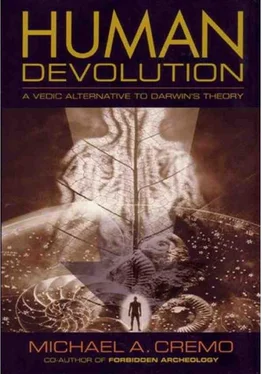Michael Cremo - Human Devolution - A Vedic Alternative To Darwin's Theory
Здесь есть возможность читать онлайн «Michael Cremo - Human Devolution - A Vedic Alternative To Darwin's Theory» весь текст электронной книги совершенно бесплатно (целиком полную версию без сокращений). В некоторых случаях можно слушать аудио, скачать через торрент в формате fb2 и присутствует краткое содержание. Год выпуска: 2003, ISBN: 2003, Издательство: Torchlight Publishing, Жанр: Старинная литература, на английском языке. Описание произведения, (предисловие) а так же отзывы посетителей доступны на портале библиотеки ЛибКат.
- Название:Human Devolution: A Vedic Alternative To Darwin's Theory
- Автор:
- Издательство:Torchlight Publishing
- Жанр:
- Год:2003
- ISBN:9780892133345
- Рейтинг книги:4 / 5. Голосов: 1
-
Избранное:Добавить в избранное
- Отзывы:
-
Ваша оценка:
- 80
- 1
- 2
- 3
- 4
- 5
Human Devolution: A Vedic Alternative To Darwin's Theory: краткое содержание, описание и аннотация
Предлагаем к чтению аннотацию, описание, краткое содержание или предисловие (зависит от того, что написал сам автор книги «Human Devolution: A Vedic Alternative To Darwin's Theory»). Если вы не нашли необходимую информацию о книге — напишите в комментариях, мы постараемся отыскать её.
Human Devolution: A Vedic Alternative To Darwin's Theory — читать онлайн бесплатно полную книгу (весь текст) целиком
Ниже представлен текст книги, разбитый по страницам. Система сохранения места последней прочитанной страницы, позволяет с удобством читать онлайн бесплатно книгу «Human Devolution: A Vedic Alternative To Darwin's Theory», без необходимости каждый раз заново искать на чём Вы остановились. Поставьте закладку, и сможете в любой момент перейти на страницу, на которой закончили чтение.
Интервал:
Закладка:
When the dark matter is added to the visible matter, the actual density of matter in the universe becomes about .30 of the critical density. For this to be the situation now, after billions of years of expansion, the ratio of the actual density of matter in the universe to the critical density had to be extremely close to unity (i.e., one to one). Rees (2000, p. 88) stated,“Our universe was initiated with a very finely-tuned impetus, almost exactly enough to balance the decelerating tendency of gravity. It’s like sitting at the bottom of a well and throwing a stone up so that it just comes to a halt exactly at the top—the required precision is astonishing: at one second after the Big Bang, Ω cannot have differed from unity by more than one part in a million billion (one in 1015) in order that the universe should now, after ten billion years, be still expanding and with a value of Ω that has certainly not departed wildly from unity.”
λ (lambda): levity in addition to Gravity?
If gravity were the only force operating in connection with the expansion of the universe, then astronomers should detect that the rate of expansion is decreasing. Gravity should be slowing down the rate at which all the material objects in the universe are moving away from each other. In short, we should observe deceleration of the expansion. The force of gravity depends on the total density of matter. The more density, the more gravity. The more gravity, the more deceleration. Depending on the exact density of matter in the universe, the rate of deceleration could be faster or slower. But there should be some deceleration, as the force of gravity counteracts the expansion. Instead, scientists have noted an apparent acceleration in the rate of expansion. This was somewhat unexpected, as it indicates that in addition to gravity there may be another fundamental natural force that is repulsive, rather than attractive. In other words, there may be antigravity in addition to gravity.
The antigravity force was discovered by scientists who were hoping to find the total amount of dark matter in the universe (Rees 2000, pp. 91–95). The visible matter in the universe contributes only .04 of the critical density. The critical density is the exact amount of matter necessary for a Big Bang expanding universe to exist for long periods of time with relatively stable stars and galaxies. There must be enough matter to slow therate of expansion so that all the matter in the universe does not quickly disperse into a featureless gas. But there must not be so much matter as to thoroughly overcome the expansion, causing the universe to quickly recollapse into a black hole. Because the visible matter in the universe is distributed in ways not possible according to the laws of gravity, scientists have inferred the existence of clumps of dark matter, which although invisible possess gravitational force. Taking into account the gravitational force of these clumps of invisible dark matter allows cosmologists to explain the distribution of visible matter. But when the clumped dark matter is added to the visible matter, the total amount of matter is still only.30 of the critical density. Some scientists have proposed that the present state of our universe would most easily be explained if the actual density of matter in the universe very closely approached the critical density, so that their ratio (Ω) was one to one (Ω = 1). But that would require that there should be some more dark matter in the universe. Therefore, some scientists have proposed that there might be large amounts of extra dark matter evenly distributed throughout the universe. Unlike the clumped dark matter, this evenly distributed dark matter would not exert noticeable gravitational force on individual galaxies. And it would therefore not show its influence in the form of anomalies in the distribution of matter in and among galaxies. However, the evenly distributed dark matter might be slowing down the overall expansion of the universe.
To test their ideas, scientists measured the red shifts of a particular type of supernova: “A distinctive type of supernovae, technically known as a ‘Type 1a’, signals a sudden nuclear explosion in the center of a dying star, when its burnt-out core gets above a particular threshold of mass and becomes unstable,” stated Rees (2000, p. 93). “It is, in effect, a nuclear bomb with a standard yield. . . . What is important is that Type 1a supernovae can be regarded as ‘standard candles’, bright enough to be detected at great distances. From how bright they appear, it should be possible to infer reliable distances, and thereby (by measuring the red shift as well) to relate the expansion speed and distance at a past epoch. Cosmologists hoped that such measurements would distinguish between a small slowdown-rate (expected if the dark matter has all been accounted for) or the larger rate expected if—as many theorists suspected—there was enough extra dark matter to make up the full ‘critical density.’” Two groups of researchers were surprised to find that their measurements of these supernova red shifts showed no deceleration effect at all. Instead, their measurements showed the rate of the expansion of the universe was actually increasing. This meant two things. First, there was not any significant amount of extra dark matter. Second, in order to explain the increase in the rate of the universe’s expansion, scientists had to propose a kind of antigravitational force.
The idea of an antigravitational force goes back to Einstein. In the 1920s, Einstein was working on the assumption that the universe was static. But his equations would not allow a universe to exist in a static state. The attractive force of gravity would cause all the matter in the universe to contract. To balance this attractive force, Einstein added to his equations a “cosmological constant,” called λ (lambda), to balance the force of gravity. When cosmologists accepted an expanding universe, they lost interest in the idea of a cosmological constant tied to equations describing a static universe. But now it turns out that the expanding universe model itself appears to require λ. What exactly does λ measure? It does not measure the force of any kind of light or dark matter. Cosmologists have been reduced to proposing that λ “measures the energy content of empty space” (Rees 2000, p. 154). The current measured value of λ appears to be quite special. “A higher-valued λ would have overwhelmed gravity earlier on, during the higher-density stages,” stated Rees (2000, p. 99). “If λ started to dominate before galaxies had condensed out from the expanding universe, or if it provided a repulsion strong enough to disrupt them, then there would be no galaxies. Our existence requires that λ should not have been too large.”
Q
According to the Big Bang cosmology, our universe started out as a small dense globular mass of extremely hot gas. As it expanded, it became cooler. If the globe of gas had been perfectly smooth, then as the expansion continued the atoms of gas would have distributed themselves evenly in space. In order for matter to have organized into structures like stars, galaxies, and clusters of galaxies, there had to have been some variations in the smoothness of the original globular cloud of gas. Some regions had to have been slightly denser than others. In these slightly more dense regions, the atoms became attracted to each other by the force of gravity, eventually becoming stars and galaxies. Rees (2000, p. 106) explains the measure of this force: “The most conspicuous structures in the cosmos—stars, galaxies, and clusters of galaxies—are all held together by gravity. We can express how tightly they are bound together—or, equivalently, how much energy would be needed to break up and disperse them—as a proportion of their total ‘rest-mass energy’ ( mc 2 ). For the biggest structures in our universe—clusters and superclusters—the answer is about one part in a hundred thousand. This is a pure number—a ratio of two energies—and we call it Q.” In other words, it would not take very much energy to overcome the force of gravity holding galaxies and clusters of galaxies together.
Читать дальшеИнтервал:
Закладка:
Похожие книги на «Human Devolution: A Vedic Alternative To Darwin's Theory»
Представляем Вашему вниманию похожие книги на «Human Devolution: A Vedic Alternative To Darwin's Theory» списком для выбора. Мы отобрали схожую по названию и смыслу литературу в надежде предоставить читателям больше вариантов отыскать новые, интересные, ещё непрочитанные произведения.
Обсуждение, отзывы о книге «Human Devolution: A Vedic Alternative To Darwin's Theory» и просто собственные мнения читателей. Оставьте ваши комментарии, напишите, что Вы думаете о произведении, его смысле или главных героях. Укажите что конкретно понравилось, а что нет, и почему Вы так считаете.












